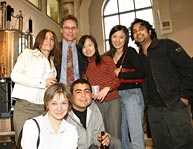Gemin X helps fund NMR Centre
Gemin X Biotechnologies, a McGill University spin-off company, has given $100,000 to the Nuclear Magnetic Resonance Spectrometry Centre. The centre, which opened in April, is based at McGill but will serve all eastern Canadian universities and numerous biotech companies.

In the Nuclear Magnetic Resonance Spectrometry Centre, (standing, left to right) Marta Bachetti, Kalle Gehring, Qian Liu, Yan Li, Nadeem Siddiqui and (front) Katya Pomerantseva and Pablo Gutiérrez.
Owen Egan
The gift, the biggest in cash from any of the private companies who have contributed to the $6.8 million centre, was key to securing funding from the Canada Foundation for Innovation and Recherche Québec programs.
"The money was critical for us in order to get funding from the federal government and to get the matching provincial funding," says Biochemistry Professor Kalle Gehring. "A cash gift means the company really believes in the project. Gemin X wants to see biotech grow in Montreal."
Other companies, such as Varian NMR Systems, for instance, a manufacturer of NMR instruments, have made contributions in kind. The California-based company donated a 500 MHz spectrometer, worth more than $1 million, now housed in the NMR Centre in the basement of the Pulp and Paper Research Centre on University Street.
But the piece de resistance in this newly renovated room is the 800 MHz spectrometer, one of only four in the country. It has a magnet so powerful that it must be encased in a 30-ton iron tomb - think of the weight of 30 cars - and even then, any item that can be demagnetized, like credit cards and some watches, must be removed before approaching the four-metre-high, shiny steel chamber.
It is into the magnetic field within the chamber that a skinny vial of protein specimen is deposited via a narrow tube. Once inside, the resonance of the nuclei of the atoms comprising the protein tells the researchers, via some electronic interpretation, how the atoms within a particular protein communicate with each other.
From Gehring's point of view, having the NMR centre on campus saves a lot of time. Before, he and other researchers in eastern Canada had to send their specimens as far away as the University of Alberta for analysis. In fact, Gehring has modeled McGill's centre after its western counterpart. Researchers from the Université de Montréal and from Queen's University are already booked to use the faculty.
While university-based researchers will tend to use the technology for pure science, private companies will do more applied testing.
Gemin X, for instance, is developing a cancer-fighting technique designed to mobilize the cancerous cells' apoptosis and will use the NMR facility to see how the drug interacts with cancerous cells. Apoptosis is the cell's normal ability to self-destruct once it becomes unhealthy. Cancerous cells, on the other hand, have lost that ability.
"Our company is trying to see what's unique to cancerous cells in order to restore the suicidal process in them," said Christian Cortis, Gemin X's director of business development. "We're trying to understand what blocks the suicidal mechanism in cancerous cells so that we can alter that process with therapy. The NMR facility will help visualize the alterations."
(Corrections have been made to this article online, therefore it differs from the print edition).
